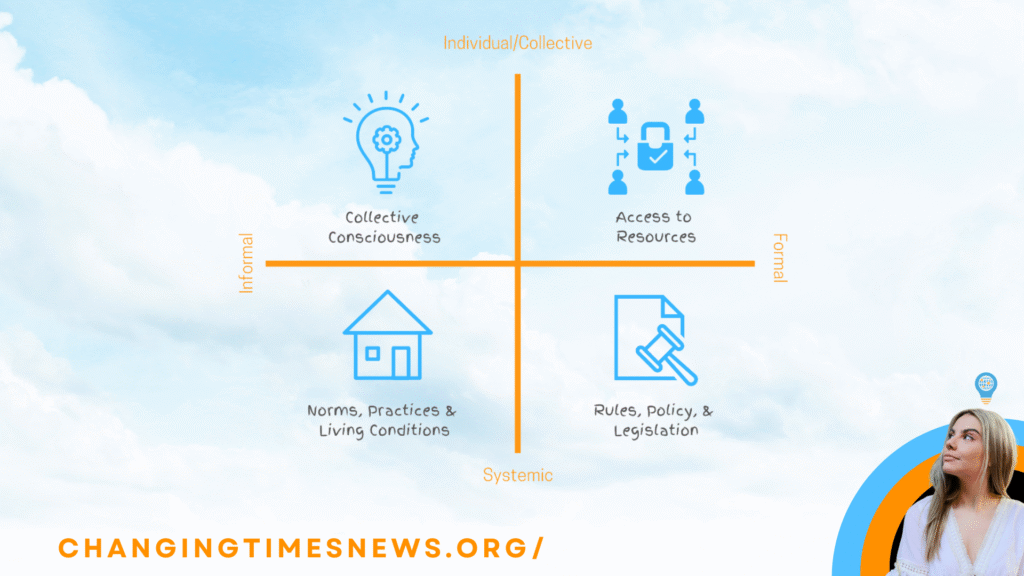When it comes to solving the world’s toughest challenges—climate change, human rights abuses, systemic inequality—traditional problem-solving methods often fall short. These are not simple issues with straightforward answers. They are what experts call “wicked problems”: complex, multi-layered challenges with no single solution.
In the latest episode of Changemaker Q&A, host Tiyana J explores how systems thinking—a holistic way of seeing and working with complexity—can help us make sense of these tangled issues and unlock more sustainable pathways for change.
Want to learn systems thinking?
Access our FREE Ultimate Introduction to Systems Thinking training bundle in Social Impact Foundations via the School of Social Impact.
A Shift in How We Think
Systems thinking challenges some of the dominant patterns of thought that have shaped modern society. Philosophers such as René Descartes popularized dualism in the 17th century, separating mind from body and, over time, encouraging a worldview of divisions: theory versus practice, individual versus collective, short-term versus long-term.
While useful in certain contexts, this kind of fragmented thinking has limited our ability to address problems that are deeply interconnected. Systems thinking pushes back against these narrow lenses. It encourages us to look at the whole picture, the relationships between parts, and the ways causes and effects loop back on each other in unpredictable, non-linear ways.
Three Waves of Systems Thinking
Emerging in the mid-20th century, systems thinking developed through three key traditions:
- Hard Systems Thinking – focused on mechanical systems with clear inputs and outputs.
- Soft Systems Thinking – applied to human-centered systems, such as healthcare and education, where multiple perspectives exist and no single “right” answer can be found.
- Critical Systems Thinking – rooted in critical theory, this approach assumes systems are not functioning optimally. It examines power imbalances and draws on social, ecological, and political dimensions to create change.
Today, systems thinkers often weave together insights from all three waves to address both technical and human-centered complexity.
Key Principles
Several characteristics distinguish systems thinking from conventional approaches:
- Holism: looking at the whole system, not just its parts.
- Non-linear causality: recognizing that small shifts can trigger large, sometimes unexpected outcomes.
- Feedback loops: outcomes feed back into systems, influencing future behavior.
- Emergence: new properties or behaviors appear when system elements interact—“the whole is greater than the sum of its parts.”
- Long-term focus: considering consequences across generations.
- Interdisciplinarity: drawing on diverse fields to understand problems fully.
From Systems Thinking to Systems Change
For those working in social change, the ultimate aim is not just incremental reform, but systems change—transforming the conditions and structures that hold problems in place. This goes beyond “systemic change” (such as passing new laws or policies) to a deeper transformation of how the system itself functions.
Applied to wicked problems like climate change, conflict, or inequality, systems thinking enables changemakers to:
- Identify root causes, not just symptoms.
- Pinpoint leverage points where small interventions create outsized impact.
- Embrace uncertainty and non-linear pathways.
- Develop solutions that are more holistic, sustainable, and inclusive.
As Donella Meadows, a pioneer of the field, famously observed in her book Thinking in Systems (Chelsea Green Publishing), leverage points in systems often lie not in pushing harder on familiar levers, but in shifting mindsets and relationships at a deeper level.
Why It Matters Now
In an era of accelerating crises, it can feel easier to focus on urgent short-term fixes. Yet as the Changemaker Q&A episode highlights, systems thinking equips us to step back, map complexity, and reimagine long-term possibilities.
Whether you’re a policymaker, activist, or grassroots organizer, embracing systems thinking means embracing humility: recognizing that no single perspective or discipline has all the answers. Instead, it’s about cultivating the capacity to see patterns, hold tensions, and co-create new futures.
Or, as Tiyana J puts it: “By shifting the way we think, we can shift the systems that shape our world.”


